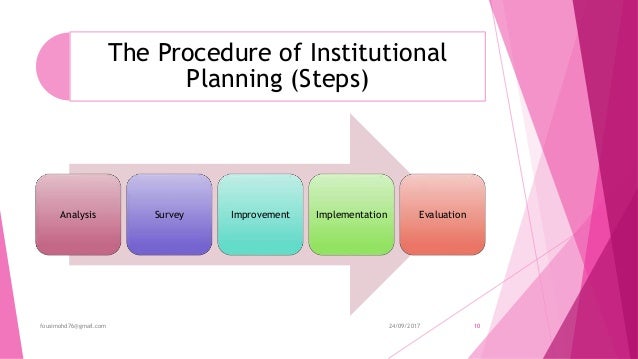Institutional Planning

According to Prof. M.B.Buch (1968) an institutional plan is a programme of development by an educational institution on the basis of its felt needs and the resource available or likely to be available with a view to improving the school programme and school practices. It is based in the principal of optimum utilization of the resources available in the school and the community. The plan may be for a longer duration or a shorter duration.
Objectives of institutional planning
• To bring improvement in the structure of educational institution
• To give proper direction to functioning of educational institutions
• To develop a comprehensive programme of improvement of educational system in all its parameters by optimum utilization of existing resources within its reach
• To provide opportunities to the members of the local community, staff and students to treat educational institutions as a joint and coo operative venture and to bring improvement in education institutions
• To give adequate freedom to teachers think to innovative and creative ideas for the improvement of institution and other programmes in the institution.
• To impart realism and concreteness to educational planning
• To shift the emphasis from expenditure orientation to the effort orientation and proper utilization of the resources. i
• To create democratic environment to enable every teacher, administrator, parent and students to take part in the formulation and implementation of the plan.
Nature and characteristics of an institutional plan
1. need based
2. specificity
3. optimum utilization
4. augmentating Human efforts
5. goal – oriented
6. cooperative in nature
7. long and short term plans
8. flexibility
NEED AND IMPORTANCE OF INSTITUTIONAL PLANNING
1. FOR BETTERMENT AND IMPROVEMENT
All institutions have some plans. All the heads of institutions make plans and each teacher also plans. In fact each headmaster and teacher does plan but this planning my not be systematic adequate and clear. This planning may not exist in a definite or regular form. Planning may mostly be routine planning of the syllabus time table and examination etc. and it may not exist in a definite or regular form and it may be repeated from term to term and from session to session without much thinking.
2. TO GIVE PROPER DIRECTION TO EDUCATIONAL OBJECTIVES
Institutional planning will gives you right direction to the educational planning in the country i.e, the upward direction from bottom to top. In the normal trend followed today the direction of planning is from top to bottom. Institutional planning is the recognition of the role of administrators‟ teachers, parents, students, educationists and social reformers in the process of planning of education in the country.
3. FOR MAXIMUM UTILIZATION OF RESOURCES
Institutional planning leads to optimum use of the existing resources. As a nation we face a great scarcity of resources with increasing needs and demands from every quarter. Therefore we must plan for maximum utilization of scarce resource.
4. FOR NATIONAL DEVELOPMENT
Educational planning must fit into the over all national planning for developmental purposes. As such it gets importance from the need for collective efforts of the people. In the words of B.D. Nag Chaudhari, Since the implementation of plan‟s and programmes is as important and vital as plan formulation. Institutional planning has a special contribution to make in national development.
5. TO ENCOURAGE INITIATIVE OF INDIVIDUAL TEACHER
Institutional plan encourages initiative freedom and creativity of the teacher makes the individual teacher effective. It motivates them too strive harder for achieving excellence. It draws out the best of the teachers.
6. FOR DEMOCRATIZATION OF PLANNING
Institutional planning democratizes the process of planning because it takes into
confidence the students the teachers the parents and the head of the institution. Sh.J.P.Naik says, “A major reform, I propose, therefore is that the planning that resembles an inverted pyramid should be broad-based and decentralized by introducing the system of institutional plans.” He strongly planed to have a fine blend of the centralized and decentralized systems of educational planning in our country.
STEPS OF INSTITUTIONAL PLANNING
1. Survey of the needs of an institution
2. survey of resources
3. determining priorities and formulation of action plan
4. execution of the plan
5. evaluation of the plan
INSTITUTIONAL PLANNING—Steps
1. ANALYSIS: Analysis of the Institution‘s present situation in terms of needs is carried out. This analysis involves:
i. School building in terms of space.
ii. Equipment and furniture are adequate.
iii. Laboratory and library equipment.
iv. Programmes which require change.
v. Staff requirements.
vi. Additional infrastructure like hostel, staff quarters, school bus, play-grounds etc.
vii. Examination system.
vii. Admission procedures.
ix. Identification of areas which require improvement, but can be done without additional resources is also analysed.
2. SURVEY: Based on the Analysis carried out, a Survey of the existing resources as well those available in the future is to be carried out. The survey must include Statistical fact and figures regarding;
1. Enrolment.
2. Staff.
3. Equipment.
4. Books.
5. Examination results.
The resources to be surveyed fall into the following categories;
a. Resources in the School. b. Resources available through the Government.
c. Resources available in the Community
3. IMPROVEMENT: Every institution must prepare a List of Improvement programmes, along with details of each programme. The programmes can be Long term or short term in nature. Each improvement programme must be specific in terms of;
i. Utility for the institution.
ii. Financial implications.
iii. Objectives must be stated in clear terms.
iv. The programmes must be clearly outlined in terms of tasks.
Each task must be specified in terms of:
i. Resources required
ii. Time schedule for each task.
iii. Expected output.
4. IMPLEMENTATION: Implementation of the Improvement programmes should follow the given guidelines;
• Available material and human resources should be utilised.
• There should be cooperation among all staff members.
• The principal would be overall in-charge and certain staff members would be
responsible for a project.
• There should be division of tasks amongst all members involved in a project.
• Commitees may be appointed to ensure smooth execution of the programmes.
• A time schedule should be prepared for the project, specifying amount of work to be done in each time period.
5. EVALUATION: At the end of implementation of an Improvement programme, it must be assessed Qualitatively and quantitatively.
• The evaluation must check whether the pre-planned objectives have been fulfilled to what extent.
• Necessary feedback must be obtained from all stakeholders and beneficiaries of the programme.
• Financial status and cost should be measured in terms of the output achieved.
Benefits of an institutional planning
- it involves the teachers the process of planning thereby making planning more
democratic in nature
- the preparation of the plan adopts the down to top approach where first hand
knowledge about the strengths , weakness and the problems arising in the classroom processes and situations is available from teachers
- it is more realistic because I it is based on the data available from then stakeholders namely students a, teachers and parents
- it avoids wastage as it is founded on knowledge about real needs of the students and the community
- it is more scientific , rational , effective and efficient rather than trial and error methods or traditional approach development.
- Each institution has a unique personality or climate and the plan prepared in the light of this climate will be more realistic and effective
- it is goal based and there fire is more efficient
- involving teachers in the process of planning motivates them , channelizes their energies towards achieving the goals , arouses enthusiasm in them , making its implementation easier
- it reduced emphasis on expenditure orientation and enhances goal orientation
- it provides ample opportunities fro creativity, innovations, initiative , freedom and experimentation to those who are involved in preparing and implementing the plans
For further reading:


Thanks For sharing. Chinmaya Vidyalaya is the best Cbse school in Vasant Vihar Delhi. It provides the best education to children. it offers the best CBSE school Vasant vihar. It aims at the student's overall unfoldment and gentle blossoming at the physical, mental, intellectual and spiritual levels of his/ her personality. if you have any enquiry visit us Chinmaya vidyalaya
ReplyDelete